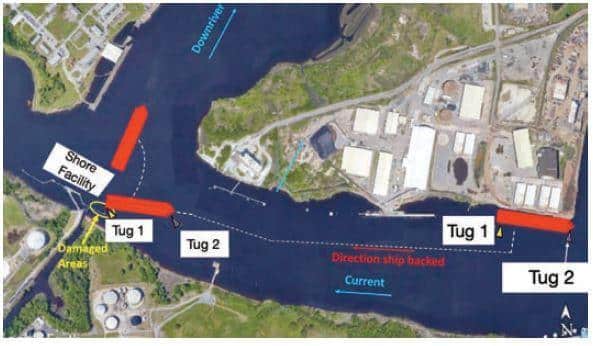

A bulk carrier was departing port with a pilot on the bridge to assist with the undocking and manoeuvre downriver. The operation was also assisted by two conventionally propelled tugs, one forward and one aft.
The docking pilot did not discuss his undocking plan with the Master, nor did he give the tug master direct information on the manoeuvre.
The usual practice was to back vessels downriver to the turning basin under tug guidance, turn the vessel approximately 90 degrees and then proceed downriver. Lines were cast off and dead slow astern was given.


As the manoeuvre progressed, the backing speed increased to about 2.9 knots. The aft tug (tug 1 in the diagram) was pushing at full power in an attempt to push the vessel’s stern north, away from the shore facility.
As the bulk carrier and tug approached the shore facility astern, the pilot requested that tug 1 stop pushing and that it be brought close by the bulk carrier.
The tugmaster complied. By now the astern speed had reached 3.2 knots and the vessels were backing quickly into a shore facility. The pilot made several ahead engine orders to try to save the situation in addition to hard starboard rudder. These actions did not prevent the bulk carrier from squeezing the tug onto the shore facility, striking a concrete pile for a mooring dolphin and then a walkway. Although damage to the tug was minimal, the shore facility suffered about $1.47 million damage.
It transpired that conventionally powered tugs were not normally used for this manoeuvre. Instead, the norm was to use more efficient tugs with 360-degree azimuth power. The official investigation found, among other things, that the speed at which the assisted vessel was being backed was too high for conventionally powered tugs to be used in an effective manner, resulting in contact with the shore facility. Another contributing factor was the less than adequate communication between the docking pilot and the bulk carrier’s Master and also the tugmasters.










We believe that knowledge is power, and we’re committed to empowering our readers with the information and resources they need to succeed in the merchant navy industry.
Whether you’re looking for advice on career planning, news and analysis, or just want to connect with other aspiring merchant navy applicants, The Marine Learners is the place to be.